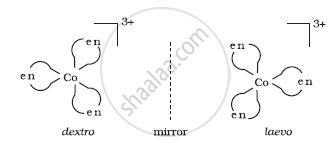Advertisements
Advertisements
प्रश्न
List various types of isomerism possible for coordination compounds, giving an example of each.
उत्तर
(i) Geometric isomerism: This type of isomerism is common in heteroleptic complexes. It arises due to the different possible geometric arrangements of the ligands. For example:
\[\begin{array}{cc}
\phantom{..}\ce{Cl}\phantom{.....}\ce{NH3}\phantom{}\\
\backslash\phantom{...}/\\
\ce{Pt}\\
/\phantom{...}\backslash\\
\ce{\underset{cis}{\phantom{..}Cl\phantom{.....}NH3}}
\end{array}\]
\[\begin{array}{cc}
\phantom{..}\ce{Cl}\phantom{.....}\ce{NH3}\phantom{}\\
\phantom{}\backslash\phantom{...}/\\
\ce{Pt}\\
/\phantom{...}\backslash\phantom{}\\
\ce{\underset{trans}{NH3\phantom{....}Cl\phantom{..}}}
\end{array}\]
(ii) Optical isomerism: This type of isomerism arises in chiral molecules. Isomers are mirror images of each other and are non-superimposable.

(iii) Linkage isomerism: This type of isomerism is found in complexes that contain ambidentate ligands. For example, [Co(NH3)5(NO2)]Cl2, which is obtained as a red form and [Co(NH3)5(ONO)]Cl2 obtained as a yellow form.
(iv) Coordination isomerism: This type of isomerism arises when the ligands are interchanged between cationic and anionic entities of different metal ions present in the complex. For example, [Co(NH3)6] [Cr(CN)6] and [Cr(NH3)6] [Co(CN)6].
(v) Ionization isomerism: This type of isomerism arises when a counter ion replaces a ligand within the coordination sphere. Thus, complexes that have the same composition but furnish different ions when dissolved in water are called ionization isomers. For example, [Co(NH3)5(SO4)]Br and [Co(NH3)5Br]SO4.
(vi) Solvate isomerism: Solvate isomers differ by whether or not the solvent molecule is directly bonded to the metal ion or merely present as a free solvent molecule in the crystal lattice. For example, [Cr(H2O)6]Cl3 (violet) and [Cr(H2O)5Cl]Cl2.H2O (grey-green).
APPEARS IN
संबंधित प्रश्न
Why dextro and laevo rotatory isomers of Butan-2-ol are difficult to separate by fractional distillation?
Answer the following question.
Draw isomers of the following
[Cr(en2)Br2]⊕
Define the term Hydrated isomers.
Draw optical isomers of [Co(en)3]3+.
Which type of isomerism is exhibited by [Pt(NH3)2Cl2]?
Draw all possible geometrical isomers of the complex \[\ce{[Co(en)2Cl2]^+}\] and identify the optically active isomer.
Identify the CORRECT statement about the following complex of platinum.
[PtCl2(en)2]2+
Which of the following does NOT show optical isomerism?
____________ isomers are formed when the ligand has two different donor atoms.
The relationship between compound (i) and (ii) is
 |
 |
| (i) | (ii) |
Complex [COCl2(en)2]+ can
Which of the following compound show optical isomerism?
Which of the following has an optical isomer?
Write the name of isomerism in the following complexes:
[Cu(NH3)4] [PtCl4] and [Pt(NH3)4] [ CuCl4]
Which compound would exhibit optical isomers?
Which among the following solid is a non-polar solid?
The compounds [PtCl2(NH3)4]Br2 and [PtBr2(NH3)4]Cl2 constitutes a pair of ______.
Name the type of isomerism exhibited by the following pair of compound:
\[\ce{[Co(NH3)5 [ONO]Cl2 and [Co(NH3)5(NO2)]Cl2}\]
Name the type of isomerism exhibited by the following pair of compound:
\[\ce{[Cr(H2O)5Cl]Cl2H2O and [Cr(H2O)4Cl2]Cl {.} 2H2O}\]
Which one of the following complex ions has geometrical isomers?
